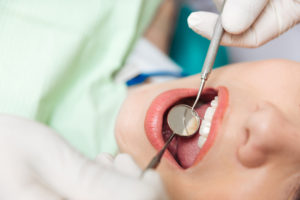Scaling and root planing (deep cleaning) is a restorative dental procedure involving the removal of plaque and calculus (tartar) stuck above and below the gum line.
The procedure is necessary after a patient’s gums, bones, and surrounding tissues become damaged due to periodontal disease (periodontitis).
Overview: What is Periodontal Disease (Periodontitis)?
Periodontal disease, also called periodontitis, is a severe inflammatory disease that affects the gums, bones, and surrounding tissues in the oral cavity.
If you do not brush your teeth twice a day or get routine teeth cleanings, the dental plaque on and between your teeth is not removed completely.
Over time, this plaque hardens into tartar, and bacteria spread to the gums. This process leads to gingivitis (early gum disease) and eventually periodontitis.
When the gums become irritated, they separate from the teeth and deep spaces form. These spaces are called “periodontal pockets.” The tartar is typically located beneath the gums (subgingival), on the base of teeth, between the gums, and on the roots of teeth.
The most common risk factors associated with periodontitis include:
- Poor brushing and flossing habits, which leads to plaque and tartar buildup
- Smoking or chewing tobacco long-term
- Poor nutrition, such as eating sugary foods and drinks often
- Some blood pressure, heart disease, cardiovascular, bacterial pneumonia, seizure, or immunosuppressant medications
- Crooked teeth, which makes the plaque and calculus more difficult to remove
- Family history of periodontitis
- Long-term stress, which causes inflammation
Symptoms of periodontitis range from mild to extreme and can include:
- Red and swollen gums
- Inflammation below or around the gums
- Gums that bleed on probing (such as flossing)
- Loose teeth or gums that pull away from the teeth
- Bad breath, even after brushing
- Pus between the teeth and gums
- Sudden teeth misalignment or an incorrect bite
Scaling and root planning involves the removal of plaque, hardened tartar (calculus), and stains from a patient’s teeth and tooth roots. The cost of scaling and root planning (deep cleanings) depends on the dentist’s location and whether or not the patient has insurance.
Your dentist typically separates the procedure into two appointments. During the first appointment, they clean the upper and lower quadrants of one side of your mouth. Then the other two quadrants are cleaned in the second appointment.
Scaling and root planing procedure steps typically include:
- Local Anesthesia Administration
Scaling and root planning requires the administration of local anesthesia, also referred to as a membrane-stabilizing drug, to help control pain and hemorrhage. Local anesthesia is the most common type of anesthesia used during minorly invasive dental procedures.
Firstly, your dentist injects the drug into your mouth and numbs the treated area. Then, after about five minutes, a temporary loss of sensation occurs. You’ll remain awake and conscious during the entire procedure but will not feel any pain. You might feel tenderness at the injection site during and after treatment.
- Scaling
The second step in the procedure is performing subgingival scaling, which is when a general dentist, periodontist, or dental hygienist removes plaque and calculus beneath the gums, between the gums, and on the base of teeth crowns.
Scaling is either done manually or with an ultrasonic instrument, such as a Calvitron. Both techniques loosen plaque and remove hardened tartar.
To remove plaque and bacteria, the scaler is placed in the pocket with the bevel at an angle between 45 and 90 degrees to the tooth. The teeth and root surfaces are then scraped and cleaned in a vertical, circular, or horizontal motion.
3. Root Planing
Dentin, cementum, enamel, and dental pulp are the four main components of teeth. As periodontitis persists, the disease typically damages the cementum, dentin, or both. Root planing is an attempt to smooth rough surfaces and remove any subgingival bacteria.
During the procedure, a dentist cleans deep below the gums to remove plaque and tartar buildup on the roots of teeth where the bones are affected by the infection. Planning involves the complete removal of cementum, which is the calcified film that covers a tooth’s root.
The procedure may also involve the removal of a small superficial layer of dentin, which is the second layer of teeth that develops below the enamel.
4. Post-Surgery
After the procedure is complete, your dentist flushes the area to remove any remaining bacteria. Then they apply pressure to ensure proper gum tissue growth.
Patients typically experience minor pain after the procedure. Properly healed gums appear as well-adapted, firm, and normally shaped tissue.
Common symptoms after treatment typically resolve within a few days and may include:
- Bleeding gums
- Irritated gums
- Tooth discomfort, such as sensitivity to hot, cold, and sugar substances
- Swelling and inflammation around the treated area
- Allergies to some of the materials used during the procedure
Practicing good oral hygiene is necessary to prevent the development of chronic periodontitis. Periodontitis is the most serious form of gum disease that results in permanent bone loss that cannot grow back. Severe periodontal disease also typically requires invasive surgery.
To prevent the need for surgery, it is crucial to practice good oral care at home. These habits include cleaning your teeth with a toothbrush twice a day, using fluoride, flossing, and rinsing with mouthwash.
Follow-up appointments are also necessary a few weeks after treatment. This is when dentists examine the healing gums and ensure the periodontal pockets have decreased in size. If the pockets are deeper than 3mm, another procedure may be needed.
Scaling and root planing treatment does not loosen your teeth. However, the long-term buildup of plaque and tartar below the gum line can loosen your teeth from the gum pockets.
A scaling and root planing procedure is to be considered effective if the patient is subsequently able to maintain their periodontal health without further bone or attachment loss and if it prevents recurrent infection with periodontal pathogens.
The long-term effectiveness of scaling and root planning depends upon a number of factors. These factors include patient compliance, disease progress at the time of intervention, probing depth, and anatomical factors like grooves in the roots of teeth, concavities, and furcation involvement which may limit visibility of underlying deep calculus and debris.
First and foremost, periodontal scaling and root planing is a procedure that must be done thoroughly and with attention to detail in order to ensure complete removal of all calculus and plaque from involved sites. If these causative agents are not removed, the disease will continue to progress and further damage will result. In cases of mild to moderate periodontitis, scaling and root planing can achieve excellent results if the procedure is thorough. As periodontitis increases in severity, a greater amount of supporting bone is destroyed by the infection. This is illustrated clinically by the deepening of the periodontal pockets targeted for cleaning and disinfection during the procedure. Once the periodontal pockets exceed 6 mm in depth, the effectiveness of deposit removal begins to decrease, and the likelihood of complete healing after one procedure begins to decline as well. The more severe the infection prior to intervention, the greater the effort required to arrest its progress and return the patient to health. Diseased pockets over 6 mm can be resolved through periodontal flap surgery, performed by a dental specialist known as a Periodontist.
Although healing of the soft tissues will begin immediately following removal of the microbial biofilm and calculus that cause the disease, scaling and root planing is only the first step in arresting the disease process. Following initial cleaning and disinfection of all affected sites, it is necessary to prevent the infection from recurring. Therefore, patient compliance is, by far, the most important factor, having the greatest influence on the success or failure of periodontal intervention. Immediately following treatment, the patient will need to maintain excellent oral care at home. With proper homecare, which includes but is by no means limited to brushing twice daily for 2–3 minutes, flossing daily and use of mouth rinse, the potential for effective healing following scaling and root planing increases. Commitment to and diligence in the thorough completion of daily oral hygiene practices are essential to this success. If the patient fails to change the factors that allowed the disease to set in – for example, not flossing or brushing only once a day – the infection will likely recur.
The process which allows for the formation of deep periodontal pockets does not occur overnight. Therefore, it is unrealistic to expect the tissue to heal completely in a similarly short time period. Gains in gingival attachment may occur slowly over time, and ongoing periodontal maintenance visits are usually recommended every three to four months to sustain health. The frequency of these later appointments is key to maintaining the results of the initial scaling and root planing, especially in the first year immediately following treatment.
Since the patient may still have pockets that surpass the effective cleaning ability of a brush or floss, for long-term success of their treatment they should return every 90 days in order to ensure that those pockets remain free of deposit. Patients should be explained that 90 days is not an arbitrary interval; at 90 days, the healing made possible by the scaling and root planing will be complete. This will allow the practitioner to re-measure pocket depths to determine whether the intervention was successful. At this appointment, progress will be discussed, as well as any refractory periodontitis. At 90 days from the original scaling and root planing, the periodontal bacteria, if any remain, will have reached their full strength again. Therefore, if there are remaining areas of disease, the practitioner will clean them again, and may place more site-specific antibiotics. Furthermore, this appointment allows for the review of homecare, or necessary additions or education.
Treatment of periodontitis may include several steps, the first of which often requires the removal of the local causative factors in order to create a biologically compatible environment between the tooth and the surrounding periodontal tissues, the gums and underlying bone. Left untreated, chronic inflammation of the gums and supporting tissue can raise a person’s risk of heart disease.
Prior to beginning these procedures, the patient is generally numbed in the area intended for instrumentation. Because of the deeper nature of periodontal scaling and root planing, either one half or one quarter of the mouth is generally cleaned during one appointment. This allows the patient to be entirely numbed in the necessary area during treatment. It is usually not recommended to have the entire mouth scaled at one appointment because of the potential inconveniences and complications of numbing the entire mouth- i.e., inability to eat or drink, likelihood of self-injury by biting, etc.
Generally, the first step is the removal of dental plaque, the microbial biofilm, from the tooth, a procedure called scaling. Root planning involves smoothing the tooth’s root. These procedures may be referred to as scaling and root planing, periodontal cleaning, or deep cleaning. These names all refer to the same procedure. The term “deep cleaning” originates from the fact that pockets in patients with periodontal disease are literally deeper than those found in individuals with healthy periodontia. Such scaling and root planning may be performed using a number of dental tools, including ultrasonic instruments and hand instruments, such as periodontal scalers and curettes.
A dental hygienist demonstrates scaling
The objective for periodontal scaling and root planing is to remove dental plaque and calculus (tartar), which house bacteria that release toxins which cause inflammation to the gum tissue and surrounding bone. Planning often removes some of the cementum or dentine from the tooth.
Removal of adherent plaque and calculus with hand instruments can also be performed prophylactically on patients without periodontal disease. A prophylaxis refers to scaling and polishing of the teeth in order to prevent oral diseases. Polishing does not remove calculus, but only some plaque and stains, and should therefore be done only in conjunction with scaling.
Often, an electric device, known as an ultrasonic scaler, sonic scaler, or power scaler may be used during scaling and root planing. Ultrasonic scalers vibrate at a high frequency to help with removing stain, plaque and calculus. In addition, ultrasonic scalers create tiny air bubbles through a process known as cavitation. These bubbles serve an important function for periodontal cleanings. Since the bacteria living in periodontically involved pockets are mainly obligate anaerobes, meaning unable to survive in the presence of oxygen, these bubbles help to destroy them. The oxygen helps to break down bacterial cell membranes and causes them to lyse, or burst.
Since it is of the utmost importance to remove the entirety of the deposit in each periodontal pocket, attention to detail during this procedure is crucial. Therefore, depending on the depth of the pocket and amount of calculus deposit versus soft biofilm deposit, hand instruments may be used to complete the fine hand scaling that removes anything the ultrasonic scaler left behind. Alternatively, power scalers may be used following hand scaling in order to dispel deposits that have been removed from the tooth or root structure, but remain within the periodontal pocket.
Two ultrasonic instruments
Sonic and ultrasonic scalers are powered by a system that causes the tip to vibrate. Sonic scalers are powered by an air-driven turbine. Ultrasonic scalers use either magneto strictive or piezoelectric systems to create vibration. Magneto strictive scalers use a stack of metal plates bonded to the tool tip. The stack is induced to vibrate by an external coil connected to an AC source. Ultrasonic scalers also include a liquid output or lavage, which aids in cooling the tool during use, as well as rinsing all the unwanted materials from the teeth and gum line. The lavage can also be used to deliver antimicrobial agents.
Although the final result of ultrasonic scalers can be produced by using hand scalers, ultrasonic scalers are sometimes faster and less irritating to the client. Ultrasonic scalers do create aerosols which can spread pathogens when a client carries an infectious disease. Research differs on whether there is a difference in effectiveness between ultrasonic scalers and hand instruments. Of particular importance to dentists themselves is that the use of an ultrasonic scaler may reduce the risk of repetitive stress injury, because ultrasonic scalers require less pressure and repetition compared to hand scalers.
A new addition to the tools used to treat periodontal disease is the dental laser. Lasers of differing strengths are used for many procedures in modern dentistry, including fillings. In a periodontal setting, a laser may be used following scaling and root planing in order to promote healing of the tissues.
After scaling
Following scaling, additional steps may be taken to disinfect the periodontal tissues. Oral irrigation of the periodontal tissues may be done using chlorhexidine gluconate solution, which has high substantively in the oral tissues. This means that unlike other mouthwashes, whose benefits end upon expectorating, the active antibacterial ingredients in chlorhexidine gluconate infiltrate the tissue and remain active for a period of time. However effective, chlorhexidine gluconate is not meant for long-term use. A recent European study suggests a link between the long-term use of the mouth rinse and high blood pressure, which may lead to a higher incidence of cardiovascular events. In the United States, it is available only through a doctor’s prescription, and in small, infrequent doses it has been shown to aid in tissue healing after surgery. Current research indicates the irrigation of CHX after SC/RP may inhibit the re-attachment of periodontal tissues. Specifically preventing the formation of fibroblasts. An alternate irrigation with povidone-iodine may be used – if no contra-indications exist.
Site specific antibiotics may also be placed in the periodontal pocket following scaling and root planing in order to provide additional healing of infected tissues. Unlike antibiotics which are taken orally to achieve a systemic effect, site specific antibiotics are placed specifically in the area of infection. These antibiotics are placed directly into the periodontal pockets and release slowly over a period of time. This allows the medication to seep into the tissues and destroy bacteria that may be living within the gingiva, providing even further disinfection and facilitation of healing. Certain site-specific antibiotics provide not only this benefit, but also boast an added benefit of reduction in pocket depth. Arestin, a popular site-specific brand of the antibiotic minocycline, is claimed to enable regaining of at least 1 mm of gingival reattachment height.
In cases of severe periodontitis, scaling and root planning may be considered the initial therapy prior to future surgical needs. Additional procedures such as bone grafting, tissue grafting, and/or gingival flap surgery done by a periodontist (a dentist who specializes in periodontal treatment) may be necessary for severe cases or for patients with refractory (recurrent) periodontitis.
Patients who present with severe or necrotizing periodontal disease may have further steps involved in their treatment. These patients often have genetic or systemic factors that contribute to the development and severity of their periodontitis. Common examples include diabetes type I and type II, a family history of periodontal disease, and immunocompromised individuals. For such patients, the practitioner may take a sample from the pockets to allow for culture and more specific identification and treatment of the causative organism. Intervention may also include discontinuation of medication that contributes to the patient’s vulnerability or referral to a physician to address an existing but previously untreated condition if it plays a role in the periodontal disease process.
Full mouth treatment
The “traditional” debridement procedure involves four sessions spaced two weeks apart, doing one quadrant (one quarter of the mouth) each session. In 1995 a group in Leuven proposed doing the whole mouth in about 24 hours (two sessions). When done using ultrasonic instruments this is called full mouth ultrasonic debridement (FMUD). The rationale for full mouth debridement is that quadrants that have been cleaned will not be reinfected with bacteria from quadrants that have not yet been cleaned. Other advantages of full mouth ultrasonic debridement include speed/reduced treatment time, and reduced need for anesthesia, with equivalent results to scaling and planning. One study found that the average time to treat each pocket with full-mouth ultrasonic debridement was 3.3 minutes, whereas it took 8.8 minutes per pocket for quadrant scaling and root planing (SRP). Differences in improvement were not statistically significant. Studies by the Leuven group, using somewhat different protocols, found that the one-stage treatment (i.e. in 24 hours) gave better results than the quadrant-by-quadrant approach (taking six weeks). They also had the patients use chlorhexidine for two months after the treatment.
Depth of Planing
Another question in dental cleaning is how much cementum or dentine should be removed from the roots. Bacterial contamination of root surfaces is limited in depth, so extensive planning away of cementum – as advocated by traditional scaling and root planing – is not necessary to allow periodontal healing and the formation of new attachment. In contrast to traditional scaling and root planing, the aim of some FMUD procedures is to disturb the bacterial biofilm within the periodontal pocket, without removing cementum. Typically, root planning will require the use of hand instruments such as specialized dental curettes instead of the scaler tips used in FMUD to debride the root surface and periodontal pocket.
















